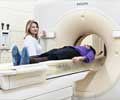Use of a combination of PET-CT imaging techniques can help predict patients' response to head and neck cancer treatment, a new study has said.
During the past two decades, chemoradiotherapy-combining chemotherapy and radiation treatments-has become important in helping preserve organs while treating advanced head and neck cancers, according to background information in the article.Lead researcher Dr James P. Malone, of the Southern Illinois School of Medicine, Springfield has suggested that imaging tests conducted six to eight weeks after patients complete chemoradiotherapy for head and neck cancer may help identify patients who will respond to treatment and those who will require surgical follow-up.
The research team analysed 31 patients with advanced-stage head and neck cancer who were treated with chemoradiotherapy between 2004 and 2006.
All patients underwent combined positron emission tomography and computed tomography (PET-CT) to detect evidence of persistent tumours six to eight weeks after the completion of treatment and then were tracked for a median (midpoint) of 24 months.
They found that response of the tumour to treatment with PET-CT had a sensitivity (rate of true positives) of 83 percent, specificity (rate of true negatives) of 54 percent, positive predictive value (probability that patients who test positive have the disease) of 31 percent and negative predictive value (probability that patients who test negative do not have the disease) of 92 percent.
In the 21 patients, whose disease had spread to surrounding lymph nodes before treatment, sensitivity was 75 percent; specificity, more than 94 percent; positive predictive value, more than 75 percent; and negative predictive value, 94 percent.
Advertisement
"On the basis of this study, PET-CT performed six to eight weeks after the completion of intra-arterial chemoradiotherapy for advanced squamous cell carcinoma of the head and neck is a valuable tool for measuring treatment response and facilitating clinical decision making," said the authors.
Advertisement
"Further investigations of PET-CT in homogenously treated patient populations with consistent timing of post-treatment scans are necessary to more clearly elucidate the role of this imaging modality in the management of advanced squamous cell carcinoma of the head and neck," they added.
The report appears in Archives of Otolaryngology-Head and Neck Surgery, one of the JAMA/Archives journals.
Source-ANI
RAS















